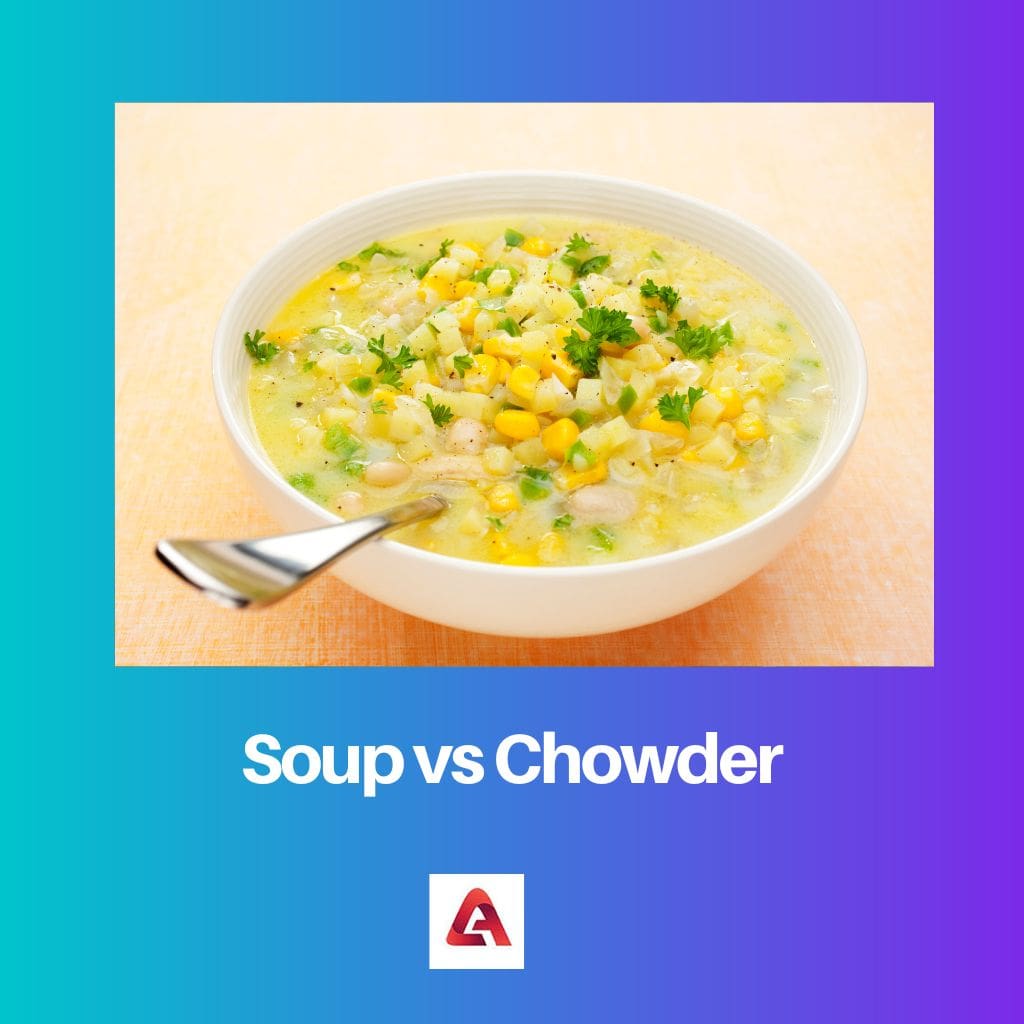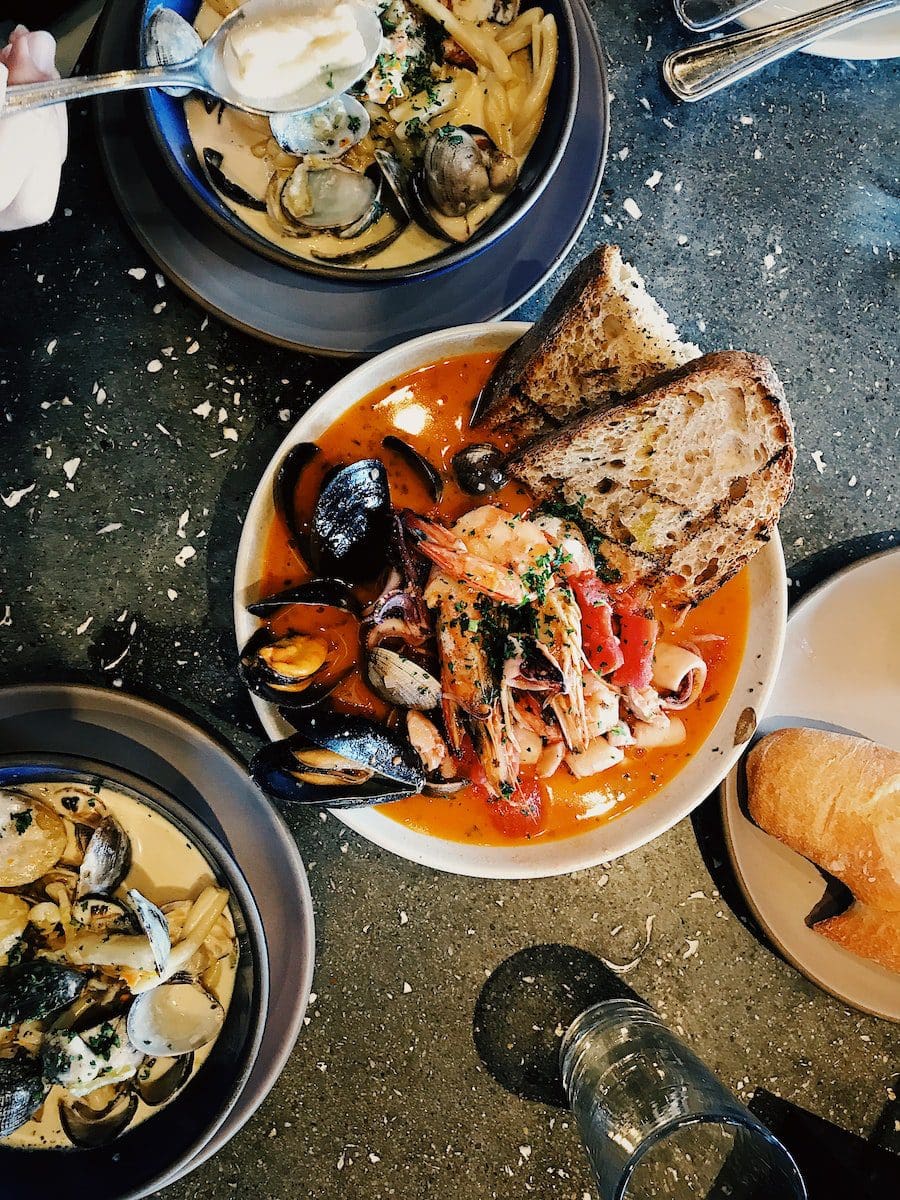Soup is a versatile, liquid-based dish featuring a clear broth and a variety of ingredients, while chowder is a thick, hearty soup made with cream or milk, potatoes, onions, and seafood or vegetables, providing a rich and indulgent dining experience.
Key Takeaways
- Soup is a liquid dish made by boiling ingredients, while chowder is a thick soup that contains seafood or vegetables.
- Soup is served as a starter, while chowder is a meal.
- Soup can be made with any ingredient, while chowder is mostly made with seafood, such as clams or fish.
Soup vs. Chowder
Soup is a primarily liquid food made by combining ingredients like meat or vegetables with stock or water, served warm. Chowder, a type of soup, is thicker, cream-based, and contains seafood or potatoes, along with other ingredients like onions and crackers.

Comparison Table
| Feature | Soup | Chowder |
|---|---|---|
| Consistency | Can be thin and watery, light and creamy, or thick and chunky. | Typically thick and creamy, with large chunks of vegetables, meat, or seafood. |
| Texture | Varies depending on the type of soup. Can be smooth, pureed, chunky, or contain noodles or other small ingredients. | Always chunky, with large pieces of ingredients like potatoes, vegetables, and meat/seafood. |
| Base | Broth or water, sometimes with added thickening agents like flour, cornstarch, or pureed vegetables. | Broth, with added cream, milk, or tomato base. |
| Main ingredients | Wide variety, including vegetables, meat, seafood, noodles, legumes, and grains. | Typically includes potatoes, vegetables, and meat/seafood, although variations exist. |
| Examples | Chicken noodle soup, tomato soup, lentil soup, minestrone, gazpacho (cold) | New England clam chowder, Manhattan clam chowder, corn chowder, seafood chowder |
| Serving temperature | Can be served hot or cold. | Almost always served hot. |
What is Soup?
Soup is a culinary staple enjoyed worldwide, cherished for its versatility, comforting nature, and ability to showcase a diverse range of ingredients. This beloved dish consists of a liquid base infused with various components such as vegetables, meats, grains, legumes, herbs, and spices, resulting in a harmonious blend of flavors and textures.
Characteristics of Soup
- Liquid Base: At the core of any soup lies its liquid foundation, which can vary from clear broths to creamy stocks. Common liquid bases include water, broth, stock, or even milk or cream for cream-based soups. This liquid serves as a vessel for infusing flavors and carrying the other ingredients.
- Diverse Ingredients: Soups are incredibly versatile, accommodating an extensive array of ingredients. From hearty vegetables like carrots, potatoes, and tomatoes to proteins like chicken, beef, seafood, or legumes such as lentils and beans, the possibilities are endless. Herbs, spices, and aromatics further enhance the depth of flavor.
- Various Consistencies: Soups come in a spectrum of consistencies, ranging from thin and brothy to thick and hearty. Consistency is achieved through the choice of ingredients and cooking techniques. Some soups are puréed for a smooth texture, while others remain chunky with visible ingredients.
Types of Soup
- Clear Soups: These soups have a transparent broth base, made by simmering meat, bones, vegetables, and seasonings. Examples include classic chicken noodle soup, beef broth, and consommé.
- Cream-based Soups: Cream-based soups are characterized by their rich and velvety texture, achieved by incorporating dairy such as milk, cream, or butter into the broth. Popular varieties include creamy tomato soup, clam chowder, and broccoli cheddar soup.
- Brothy Soups: Brothy soups feature a light and flavorful liquid base, enriched with vegetables, meats, and grains. They are known for their simplicity and are frequently enjoyed as light meals or starters. Examples include minestrone, miso soup, and pho.
- Chunky Soups/Stews: These heartier soups are packed with substantial chunks of ingredients like meat, potatoes, and vegetables, providing a more substantial and filling meal. Beef stew, chili, and vegetable barley soup are prime examples.

What is Chowder?
Chowder is a beloved type of soup that originated in North America, particularly in regions with abundant seafood, such as New England. Renowned for its rich and creamy consistency, chowder is a comforting dish that features a hearty base complemented by a variety of ingredients, most commonly including seafood, potatoes, onions, and sometimes corn.
Characteristics of Chowder
- Creamy Base: Unlike traditional soups, chowder is distinguished by its thick and creamy base, achieved by incorporating heavy cream or milk. This creamy texture lends a luxurious mouthfeel and serves as a canvas for the robust flavors of the other ingredients.
- Abundant Ingredients: Chowder is characterized by its generous portions of ingredients, particularly seafood such as clams, shrimp, crab, or fish. Alongside seafood, chowder includes diced potatoes, onions, celery, and sometimes corn, providing a satisfying mix of flavors and textures.
- Regional Variations: Chowder recipes can vary regionally, with New England clam chowder being one of the most iconic variations. New England clam chowder features tender clams, potatoes, onions, and sometimes bacon, all simmered in a creamy broth. Other regional variations include Manhattan clam chowder, which features a tomato-based broth, and corn chowder, which highlights sweet corn as a primary ingredient.
Types of Chowder
- New England Clam Chowder: This classic chowder originated in the northeastern United States and is renowned for its creamy base, tender clams, diced potatoes, onions, and occasionally, crispy bacon. It is a comforting and indulgent dish enjoyed particularly during the colder months.
- Manhattan Clam Chowder: Unlike its creamy counterpart, Manhattan clam chowder features a tomato-based broth, giving it a tangy and slightly acidic flavor profile. Alongside clams, it includes tomatoes, potatoes, onions, carrots, and celery, offering a vibrant and hearty alternative to New England clam chowder.
- Corn Chowder: Corn chowder showcases sweet corn as the star ingredient, combined with a creamy base and featuring potatoes, onions, and other vegetables. It offers a delightful balance of sweetness and creaminess, making it a popular choice, especially during the summer months.

Main Differences Between Soup and Chowder
- Base Consistency:
- Soup has a liquid or broth base, whereas chowder features a thick and creamy base, achieved with cream or milk.
- Ingredients:
- Soup can contain a wide variety of ingredients including vegetables, meats, grains, legumes, and spices, while chowder commonly includes seafood (such as clams, shrimp, or fish), potatoes, onions, and sometimes corn.
- Texture:
- Soups have a lighter, more liquid texture, while chowder is characterized by its rich and hearty consistency, with chunky ingredients suspended in a creamy broth.
- Regional Variations:
- Soups have diverse global variations, reflecting local cuisines and ingredients, whereas chowder is most commonly associated with North American cuisine, particularly in regions like New England, and has variations such as New England clam chowder and Manhattan clam chowder.




